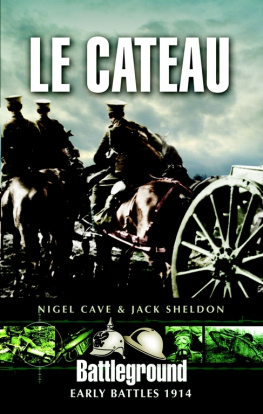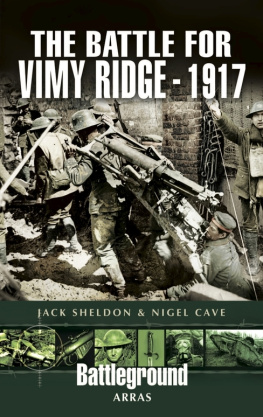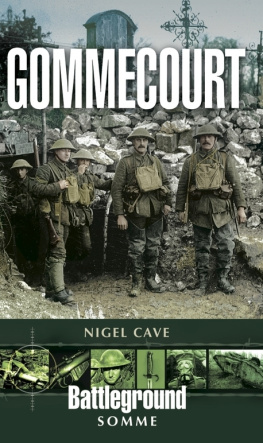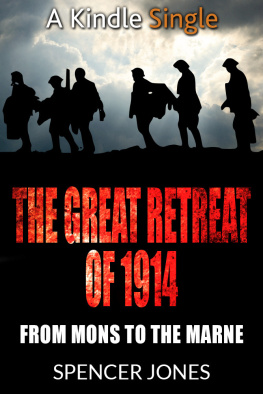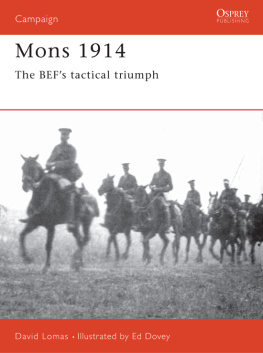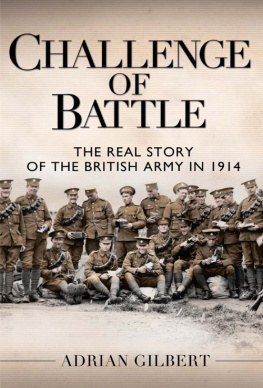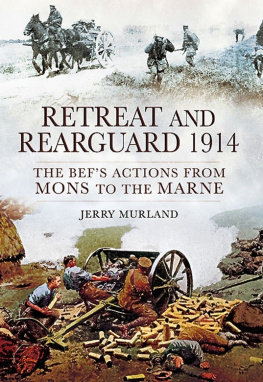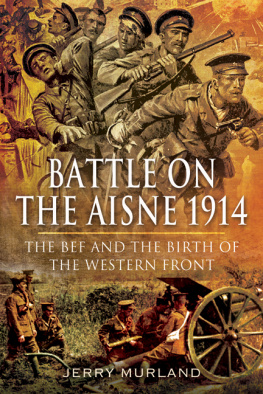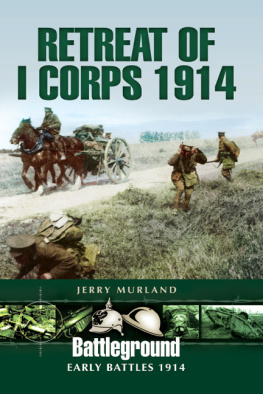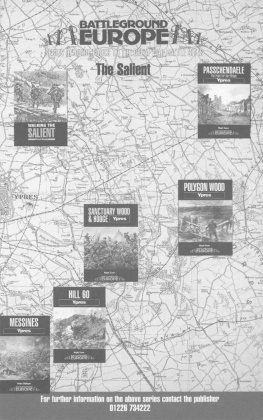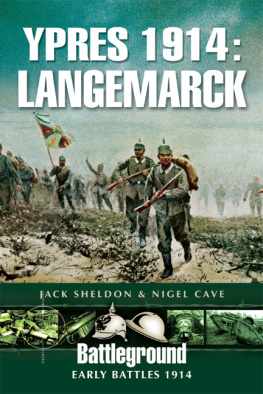Nigel Cave - Le Cateau
Here you can read online Nigel Cave - Le Cateau full text of the book (entire story) in english for free. Download pdf and epub, get meaning, cover and reviews about this ebook. year: 2008, publisher: Pen and Sword Military, genre: Non-fiction. Description of the work, (preface) as well as reviews are available. Best literature library LitArk.com created for fans of good reading and offers a wide selection of genres:
Romance novel
Science fiction
Adventure
Detective
Science
History
Home and family
Prose
Art
Politics
Computer
Non-fiction
Religion
Business
Children
Humor
Choose a favorite category and find really read worthwhile books. Enjoy immersion in the world of imagination, feel the emotions of the characters or learn something new for yourself, make an fascinating discovery.
- Book:Le Cateau
- Author:
- Publisher:Pen and Sword Military
- Genre:
- Year:2008
- Rating:4 / 5
- Favourites:Add to favourites
- Your mark:
- 80
- 1
- 2
- 3
- 4
- 5
Le Cateau: summary, description and annotation
We offer to read an annotation, description, summary or preface (depends on what the author of the book "Le Cateau" wrote himself). If you haven't found the necessary information about the book — write in the comments, we will try to find it.
Le Cateau — read online for free the complete book (whole text) full work
Below is the text of the book, divided by pages. System saving the place of the last page read, allows you to conveniently read the book "Le Cateau" online for free, without having to search again every time where you left off. Put a bookmark, and you can go to the page where you finished reading at any time.
Font size:
Interval:
Bookmark:
As for all the Battleground books, we owe most of our information to the authors of the regimental histories of both sides. Although by definition, almost, these are likely to be partisan works, they provide a wealth of information and personal accounts of the events on the battlefield. The Battle of Le Cateau is blessed by very full accounts in many of these works, particularly on the British side. We are extremely grateful to them. Ironically, the official records tend to be very patchy and never very full an inevitable consequence of the conditions under which these early battles of the Great War were fought. Some of the battalion War Diaries, for example, consist of only a couple of lines. We would particularly like to express our thanks to Colonel Pat Love, MBE, of the Worcestershire Regiments RHQ, who has always been the source of a wealth of information and who can also stand for the many other volunteers who carry out this function for the regiments of the British army of the time.
As usual we are indebted to Roni Wilkinson (and the other members of the Wilkinson dynasty, Paul and Jonathan) at Pen and Sword; the working relationship now spans twenty years and the same patience and enthusiasm has been displayed to at least one of the authors throughout those years.
Thanks are due to Arlene King, Directrice of the Beaumont Hamel Newfoundland Memorial, for her generous hospitality during the period in which the field work for this book was undertaken. Nigel Cave particularly thanks Brother Shinto Kumminiyil IC for sacrificing a couple of days of his very limited time in France to touring this battlefield in search of photographs. We also acknowledge the help provided by the Le Cateau tourist office and to various enthusiasts in the area who have made available some of their collection of illustrations: Grard Lemoine of St Benin, Grard Delmotte of Caudry, Philippe Gorcyzinski of Cambrai and Dominique Lechef.
The Commonwealth War Graves Commission continues to impress with the never ending hard work that makes even the most remote and unvisited cemeteries gardens suitable for the resting place of those who gave their lives during the war; whilst its excellent web site has ensured that it is much easier to direct people to the place of commemoration of so many who died as a result of the fighting on 26 August 1914.
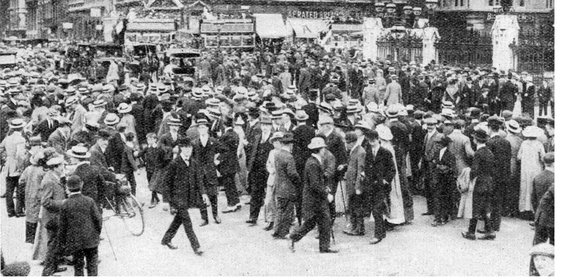
Crowds in front of the Houses of Parliament waiting for news of the declaration of war.
British infantry in northern France.
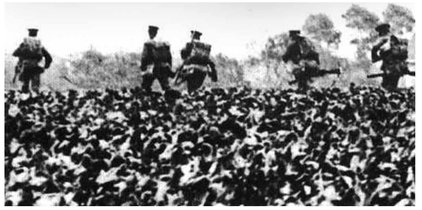
British artillery passing through a French village.

See Map p. 201
Amongst the first to be involved in the fighting at Le Cateau were the two elements of the 5th Division that happened to be to the east of, and almost in, Le Cateau itself that is the 1st Duke of Cornwalls Light Infantry (1/DCLI) and the 1st East Surreys (1/E Surrey). This part of Fifth Division was to maintain contact with I Corps, further to the east (or, at least, that was the idea). The DCLIs excellent regimental history (The History of the DCLI 1914 1919, Everard Wyrall) provides most of the material for what follows. At the outbreak of the war it required no less than 650 reservists (ie about 60% of a mobilised battalions establishment) to bring it up to strength, These men had to be assembled at Bodmin, the Regimental Depot, kitted out and shipped to the Curragh, near Dublin: and this was achieved within two days of mobilisation being ordered. Almost every man called up appeared at the depot the exceptions (two) were at sea. If nothing else, this is a tribute both to the telegram system of the day and the quality of the contemporary public transport.
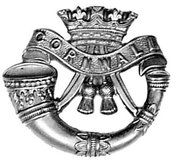
Note that letters in bold and in parenthesis are to be found on the map extracted from the DCLI history. 1/DCLI had suffered relatively few casualties during its time on the extreme left of the line (for much of the time) at Mons. Similarly, although being the rearguard of 14 Brigade and of the 5th Division from early morning until about 2pm on 25 August, it suffered few casualties from the enemy. However, from that time onwards, men began to fall out, utterly exhausted. It was very hot indeed, a heat that was relieved somewhat by a torrential downpour that commenced at about 5pm. The bivouac positions for 1/DCLI and half of 1/E Surrey were to the east of Le Cateau; they arrived at about 6pm after a march of over twenty three miles and were utterly worn out and completely soaked. Not only was it a march of twenty three miles one has to include the heat, the extremely crowded and confused road traffic conditions and the great clouds of dust through which they would have had to march, never mind the rumble of firing and the threat of a probing enemy.
We bivouacked, in a drenched condition, in a field at the fork road [ie the Pommereuil road] on the south eastern outskirts of the town just as it became dark. The men were served out with rations, the first since 8pm the previous night. It may safely be said that the men were in an exhausted condition after the previous four days continuous strain and a rest was much hoped for.
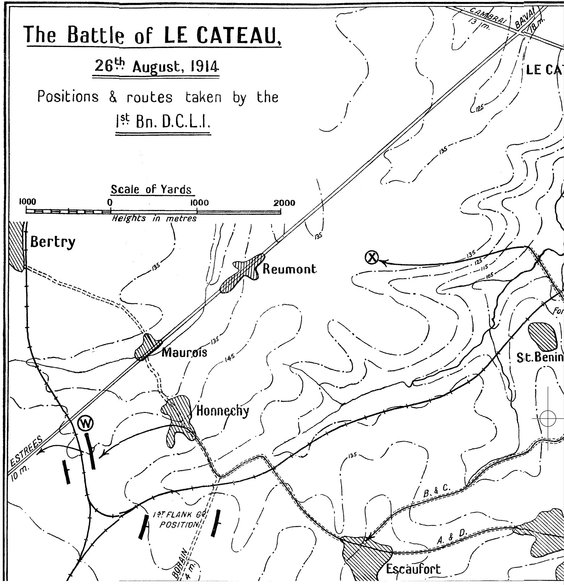
Map 4. The east of the battlefield, particularly that of 1st Duke of Cornwall Light Infantry.
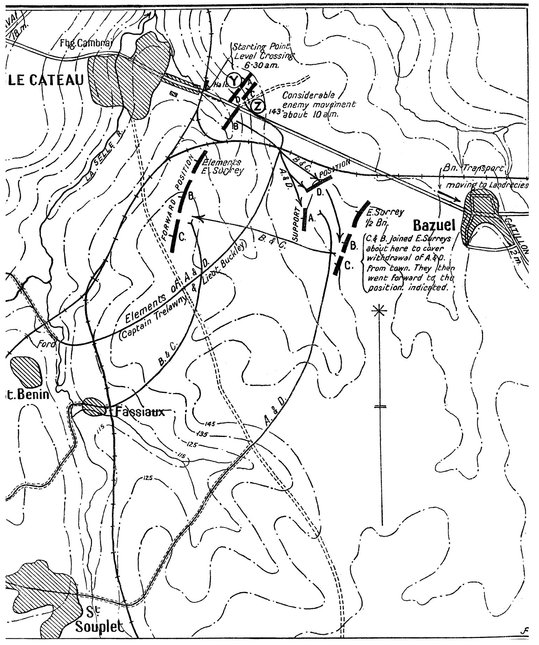
Early on that memorable day the Cornwalls, after a wretched night, stood to arms. It was still dark and their clothes were sodden with rain: many had not slept at all, even exhausted as they were on the previous night. Stand To was the worst hour of the day: chilled through and drowsy, the bitter change from oblivion to consciousness amidst all the gloomy surroundings of war was a thing men experienced not only in those early days of 1914 but throughout the long years in France and Flanders that followed. Sleep was the only sedative, an anodyne which took away all remembrance: the thing which allayed pain, blotted out for an all too short period the ghastly horrors and surroundings of the battlefield.
The Battalion was due to continue its retirement at 6.30am in line with Frenchs original orders and no official order arrived to change that intention. It was all set up, in column of route (Y) , with its head near the level crossing, to proceed from the eastern end of town through it and then off in a south westerly direction when, at the very moment set for departure, it came under small arms fire. Although some shelling had taken place to the west of the town shortly before this time, the DCLI were the first to be fired upon by infantry in what the British subsequently called the Battle of Le Cateau. The shots came from houses on the town side of the railway, about a hundred yards to the west of the assembled Battalion; although the Commanding Officers horse was hit, most of the damage was done to the Brigade Signals Section, which was already on the west side of the bridge Situated with them was part of 14 Brigade HQ, and Lieutenant J Dennis of the DCLI, the Brigade Machine-Gun Officer, was killed. (He has no known grave.) Immediately the men retired, through fields of allotments, to some high ground to the rear and occupied positions across the road (Z) . The two and half companies of the East Surreys took up a position south of the road and to the rear of 1/DCLI.
Font size:
Interval:
Bookmark:
Similar books «Le Cateau»
Look at similar books to Le Cateau. We have selected literature similar in name and meaning in the hope of providing readers with more options to find new, interesting, not yet read works.
Discussion, reviews of the book Le Cateau and just readers' own opinions. Leave your comments, write what you think about the work, its meaning or the main characters. Specify what exactly you liked and what you didn't like, and why you think so.

